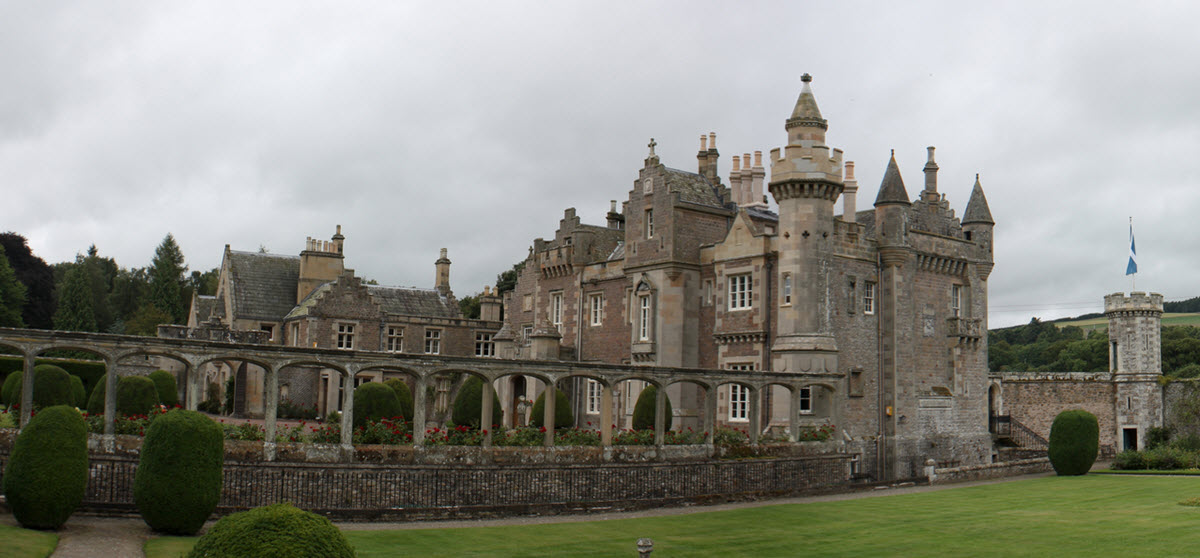Contents
Located on the River Tweed, Abbotsford House was built for the Scottish historical novelist, poet, playwright, and historian Sir Walter Scott. Nowadays, it is a Category A Listed Building and the estate is listed in the Inventory of Gardens and Designed Landscapes in Scotland.
Is it open to the public?
Yes, Abbotsford House is open to the public.
It was opened to the public in 1833, the year after Scott´s death, but the Scott family continued to live there until 2004. The last member of the family to hold the Lairdship of Abbotsford was Dame Jean Maxwell-Scott (1923-2004). Together with her sister Patricia Maxwell -Scott, she turned Abbotsford House into one of Scotland´s most popular tourist destinations.
The new Visitor Centre, inaugurated in 2012, includes café/restaurant, gift shop and a small exhibition.

Where is Abbotsford House?
Abbotsford House is located in the Scottish Borders (Scots: The Mairches) in the eastern part of the Southern Uplands. The estate is beautifully situated on the southern bank of the River Tween, not far from the town Galashiels.
Coordinates: 55°35′59″N 2°46′55″W
Short facts about Abbotsford House
Name: Abbotsford House
Type: Baronial mansion
Architectural style: Gothic, Scottish Baronial
Owner: Scott Family
The building
The general ground-plan for Abbotsford House is a parallelogram with irregular outlines, and one side overlooks the River Tweed. The manor can be described as a “mini-castle”, with its diminutive towers and imitation battlements. The style of the Abbotsford House came to be a very powerful influence for the Scottish Baronial style, and aspects of this manor house can be seen across many buildings in the region.
Scott desired an old-fashion feeling, but also wanted modern comforts and wasn´t afraid to test out new inventions and add them to his house – such as gaslighting and pneumatic servant bells.
Incorporations
Scott incorporated a lot of artefacts from older buildings into Abbotsford House, e.g. the doorway from The Old Tolbooth in Edinburgh. Many of these artefacts have been built into the walls of the South Garden. Along one of the garden paths, you can, for instance, see the remains of Edinburgh´s 15th century Mercat Cross.
History
Background
The estate has its roots in a small farm – just 100 acres – named Carthleyhole but nicknamed Clarty Hole (which means muddy hole). Sir Walter Scott purchased this farm in the 1810s and built a small villa here that he named Abbotsford, a name derived from a nearby ford where the abbots of Melrose Abbey used to cross the river.
Various additions to the villa turned it into a mansion, one that incorporated into its walls plenty of salvaged sculptural stones from ruined Scottish castles and abbeys.
In 1817, Scott acquired Toftfield (now known as Huntlyburn) and started building Abbotsford House. The new house was completed in 1824.
Financial difficulties
Very soon after the completion of Abbotsford House, Scott´s economy took a turn for the worse due to a UK-wide banking crisis. Scott placed his house and income in a trust belonging to his creditors and was determined to write his way out of debt. In 1832, he died at Abbotsford, during a typhus epidemic. In 1847, the publisher Robert Cadell cleared all debts associated with the estate in exchange for the family´s share in the copyright of Scott´s work.
